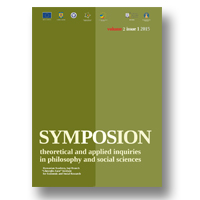|
research articles |
|
1.
|
Symposion:
Volume >
4 >
Issue: 2
Alex Blum
Can It Be that Tully=Cicero?
abstract |
view |
rights & permissions
| cited by
We show, that given two fundamental theses of Kripke, no statement of the form ‘‘a=b’ is necessarily true’, is true, if ‘a’ and ‘b’ are distinct rigid designators.
|
|
|
|
|
2.
|
Symposion:
Volume >
4 >
Issue: 2
Michael Campbell
Companions in Guilt Arguments and Moore's Paradox
abstract |
view |
rights & permissions
| cited by
In a series of articles Christopher Cowie has provided what he calls a ‘Master Argument’ against the Companions in Guilt (CG) defence of moral objectivity. In what follows I defend the CG strategy against Cowie. I show, firstly, that epistemic judgements are relevantly similar to moral judgements, and secondly, that it is not possible coherently to deny the existence of irreducible and categorically normative epistemic reasons. My argument for the second of these claims exploits an analogy between the thesis that epistemic norms are non-categorical and G.E. Moore’s paradox concerning first personal belief ascriptions. I argue that the absurdity of the assertion “I have evidence that p but no reason to believe it” shows that the norms of belief are categorical. I then consider the counter-argument that this categoricity is a ‘conceptual’ rather than an ‘objective’ requirement. By drawing on the work of Hilary Putnam and Charles Travis, I show that this counter-argument is unsuccessful. Putnam is one of the original proponents of the Companions in Guilt strategy. Thus, by supporting the CG argument through appeal to other Putnamian theses, I show that its insights can only fully be appreciated in the context of broader metaphysical and semantic lessons.
|
|
|
|
|
3.
|
Symposion:
Volume >
4 >
Issue: 2
Arnold Cusmariu
The Prometheus Challenge Redux
view |
rights & permissions
| cited by
|
|
|
|
|
4.
|
Symposion:
Volume >
4 >
Issue: 2
Hili Razinsky
Ambivalence, Emotional Perceptions, and the Concern with Objectivity
abstract |
view |
rights & permissions
| cited by
Emotional perceptions are objectivist (objectivity-directed or cognitive) and conscious, both attributes suggesting they cannot be ambivalent. Yet perceptions, including emotional perceptions of value, allow for strictly objectivist ambivalence in which a person unitarily perceives the object in mutually undermining ways. Emotional perceptions became an explicandum of emotion for philosophers who are sensitive to the unique conscious character of emotion, impressed by the objectivist character of perceptions, and believe that the perceptual account solves a worry about the possibility of a conflict between an emotion and a judgement. Back into the 1980s Greenspan has argued that emotional ambivalence is possible, her reasons implying that objectivist accounts of emotion are inconsistent with ambivalence. Tappolet has more recently replied that perceptual accounts allow for emotional ambivalence since the opposed values seen in ambivalence are good or bad in different senses. The present paper identifies strict objectivist ambivalence between judgements and between emotional perceptions by contrasting them with such ambivalence of separate values such as evoked by Tappolet.
|
|
|
|
|
discussion notes/debate |
|
5.
|
Symposion:
Volume >
4 >
Issue: 2
Rocco J. Gennaro
In Defense of H.O.T. Theory:
A Second Reply to Adams and Shreve
abstract |
view |
rights & permissions
| cited by
In Gennaro (2016), I had originally replied to Fred Adams and Charlotte Shreve’s (2016) paper entitled “What Can Synesthesia Teach Us About Higher Order Theories of Consciousness?,” previously published in Symposion. I argued that H.O.T. theory does have the resources to account for synesthesia and the specific worries that they advance in their paper, such as the relationship between concepts and experience and the ability to handle instances of ‘pop-out’ experiences. They counter-reply in Adams and Shreve (2017) and also raise further objections to H.O.T. theory which go well beyond the scope of their 2016 paper. In this paper, I offer additional replies to the points they raise in Adams and Shreve (2017).
|
|
|
|
|
6.
|
Symposion:
Volume >
4 >
Issue: 2
Terence Rajivan Edward
Artefacts as Mere Illustrations of a Worldview
abstract |
view |
rights & permissions
| cited by
This paper responds to an argument against a kind of anthropology. According to the argument, if the aim of anthropology is to describe the different worldviews of different groups, then anthropologists should only refer to material artefacts in order to illustrate a worldview; but the interest of artefacts to anthropology goes beyond mere illustration. This argument has been endorsed by key members of the ontological movement in anthropology, who found at least one of its premises in Marilyn Strathern’s writing.
|
|
|
|
|
|
|
7.
|
Symposion:
Volume >
4 >
Issue: 2
Information about Authors
view |
rights & permissions
| cited by
|
|
|
|
|
|
|
8.
|
Symposion:
Volume >
4 >
Issue: 2
About the Journal
view |
rights & permissions
| cited by
|
|
|
|
|
|
|
9.
|
Symposion:
Volume >
4 >
Issue: 2
Author Guidelines
view |
rights & permissions
| cited by
|
|
|
|
